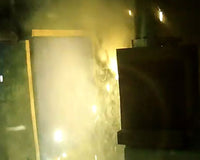Most people that work with electricity are well aware of the danger that an Arc Flash incident possess. Whilst, they may recognise that they need to wear PPE when working in those environments where there is the potential for an Arc Flash to occur, very few are actually aware of what the requirement are.
What PPE is required for Arc Flash?
It’s important to know that not all PPE is suitable for use in Arc Flash environments. Depending on the incident energy level of the equipment, certain category levels of Arc Flash PPE are required to be worn. The incident energy levels should be clearly labelled and are listed in cal/cm2. This value represents the very highest energy level that the equipment will produce in the unfortunate event of an Arc Flash.

All Arc Flash PPE and clothing items have tags in them which detail the Arc Thermal Protective Value (ATPV) of the garment. This is displayed in cal/cm2. The APTV demonstrates the energy level that it will protect up to in the event of an Arc Flash. For instance, a shirt with an APTV of 25 cal/cm2, will protect the wearer up to this level only. It is, therefore, extremely important that all workers wear PPE and clothing that has an APTV that is greater than the incident energy level of the equipment they are working with.
How to make sure the correct PPE is worn?
There are two separate steps that should be used to determine if the correct type of PPE is being worn for the task at hand.
Identify the risk – where there is the risk of an arc flash within a particular work environment, its severity must first be determined. This is defined by the incident energy level. If the equipment has been assessed, there will be a label on it that details exactly what this is and may even say what the minimum level of PPE is. For instance, if a label says the incident energy level is 4.6 cal/cm2 and a worker is wearing Arc Flash PPE with a rating of 8 cal/cm2 then they can rest assured that they are sufficiently protected.
In those situations where these isn’t a label, then the NFPA 70E Table 130.7(C)(15)(A) (tables A&B) should be referenced. From the information available in these tables, it is easy to determine the minimum level of PPE that’s required.
Ensure protection from head to toe – there is more to Arc Flash PPE than gloves and a shirt or overall. Depending on the level of exposure, there are various garments that workers are required to wear in order to ensure that they’re sufficiently protected in the unfortunate event of an Arc Flash incident. However, regardless of the level of risk, it is always good practice for workers to be covered from head to toe in Arc Flash PPE. This could include wearing overalls, balaclava, safety helmet, eyewear, footwear and gloves for example. See our collection of Arc Flash Kits here to understand what different options are on the market.
It is also good practice to regularly inspect safety garments to make sure that there isn’t any damage, such as holes and / or tears. This is because damage like this can seriously compromise the garments ability to withstand a Arc Flash hazard.





